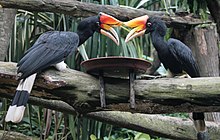Rhinoceros hornbill
| Rhinoceros hornbill | |
|---|---|

| |
| A pair in Singapore Zoo | |
| Scientific classification | |
| Domain: | Eukaryota |
| Kingdom: | Animalia |
| Phylum: | Chordata |
| Class: | Aves |
| Order: | Bucerotiformes |
| Family: | Bucerotidae |
| Genus: | Buceros |
| Species: | B. rhinoceros
|
| Binomial name | |
| Buceros rhinoceros | |
The rhinoceros hornbill (Buceros rhinoceros) is a large species of forest
The rhinoceros hornbill is the state bird of the
Taxonomy
The rhinoceros hornbill was
Three subspecies are recognised:[8]
- B. r. borneoensis Schlegel & Müller, S, 1845 – Borneo
- B. r. rhinoceros Linnaeus, 1758 – south Malay Peninsula and Sumatra
- B. r. silvestris Vieillot, 1816 – Java
Description

The rhinoceros hornbill is a large arboreal hornbill, 80 to 90 cm (31–35 in) long. The weight varies by sex, with males weighing around 2,465 to 2,960 g (87.0–104.4 oz) and the females 2,040 to 2,330 g (72–82 oz). The plumage is predominantly black, with white legs and vent and a white tail with a black band. The huge bill and casque are orange and red, the colour coming from preen oil rubbed on from the preen gland above the tail. The eyes of the male are red with black rims, and white with red rims in the female.[9]
Behaviour
Diet and feeding

The diet of the rhinoceros hornbill is dominated by fruit, but it will take any insect, small reptile, rodent, and smaller birds that it can catch.[9]
Breeding
The courtship and bonding of these birds are critical, as the female must trust the male to provide her with everything when she is incubating and raising chicks. These hornbills make their nests inside tree trunks,[10] and the female stays inside with the eggs and then with the chicks, while the male brings them food. After the eggs are laid, the male collects mud, and the pair pack that mud, along with food and feces, to wall up the entrance to the tree cavity. They leave a very small hole, just large enough for the male to feed the female, and later the chicks, and for the female to defecate through the hole. Once the chicks are fully feathered and old enough to leave the nest, the parents chip away the dry mud to let the chicks out.
Status and conservation
The rhinoceros hornbill faces a number of threats, including loss of its rainforest habitat, as well as hunting for its meat, and its skull and feathers.[1] Habitat destruction has led to the loss of the large trees the species requires for breeding, which in turn makes it easier for poachers to find the rhinoceros hornbill. It is frequently shot at by poachers due to confusion with the highly sought-after helmeted hornbill. Due to this, the species was uplisted to vulnerable from near threatened on the IUCN Red List in 2018.[11]
Gallery
-
Sepilok Nature Resort - Sabah, Borneo - Malaysia.
-
Borneo Rainforest Lodge - Danum Valley, Sabah, Borneo - Malaysia.
-
Male at the National Aviary, Pittsburgh. Males have red irises.
-
Female at Chester Zoo, England
-
Buceros rhinoceros silvestris at Weltvogelpark Walsrode, Germany
-
Female at Birdworld, England
References
- ^ . Retrieved 18 November 2021.
- ^ "Appendices | CITES". cites.org. Retrieved 2022-01-14.
- ^ Kenyalang - State Bird of Sarawak (Archive, December 2005). Sarawak Tourism Board.
- ^ "Harrisson and Sandin give a slightly different interpretation. They state that the Hornbill image is used to show it, in an independent sense, as 'Chief of the Birds'. According to them it does not represent Lang, but quite simply represents a Hornbill, 'the Supreme Worldly Bird, who welcomes the invisible overhead approach of the God of Birds, Sengalang Burong' (1966: 124)." See p80 V. King Unity, formalism and structure: Comments on Iban augury and related problems. With a rejoinder by Peter Metcalf In: Bijdragen tot de Taal-, Land- en Volkenkunde 133 (1977), no: 1, Leiden, 63-89.
- ^ Benedict Sandin (1977). GAWAI BURONG the chants and celebrations of the Iban Bird Festival. Pb. Univ. Sains Malaysia.
- ^ Linnaeus, Carl (1758). Systema Naturae per regna tria naturae, secundum classes, ordines, genera, species, cum characteribus, differentiis, synonymis, locis (in Latin). Vol. 1 (10th ed.). Holmiae (Stockholm): Laurentii Salvii. p. 104.
- ISBN 978-1-4081-2501-4.
- Rasmussen, Pamela, eds. (January 2022). "Mousebirds, Cuckoo Roller, trogons, hoopoes, hornbills". IOC World Bird List Version 12.1. International Ornithologists' Union. Retrieved 10 June 2022.
- ^ ISBN 978-84-87334-30-6.
- ^ Law, Yao-Hua (2020-12-16). "An Enormous Bird Has a Real-Estate Problem". The Atlantic. Retrieved 2024-03-03.
- ^ BirdLife International. "Red List: Northern Bald Ibis, Pink Pigeon making a comeback". BirdLife. Retrieved 2018-11-23.
- ISBN 978-1-55297-777-4.








